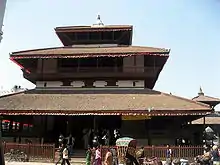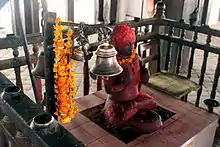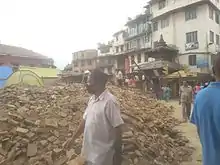Kasthamandap
Kasthamandap (Sanskrit: काष्ठमन्डप, Nepal Bhasa:मरु सत: Maru Satta:; literally "Wood-Covered Shelter") was a three-storied public shelter that included a shrine consecrated to Gorakshanath situated at Maru, Kathmandu, Nepal.[1][2] Several myths and stories about the date of the construction of the Kasthamandap Temple have been resolved with the recent archeological findings. The newly discovered objects during the excavation here in the aftermath of the 2015 earthquake have suggested that the Kasthamandap may have been built in the 7th century during the Lichhavi era.[3]
| Kasthamandap | |
|---|---|
 Front view of Kasthamandap | |
| Religion | |
| Affiliation | Hinduism |
| District | Kathmandu |
| Location | |
| Location | Kathmandu |
| State | Bagmati |
| Country | Nepal |
 Shown within Kathmandu Valley | |
| Geographic coordinates | 27.70400°N 85.30583°E |
| Architecture | |
| Type | Pagoda |

A team of international and national experts from the Department of Archaeology (DoA), Government of Nepal and Durham University had excavated beneath the Kasthamandap and found coal and sand in the foundations. The foundation soil, coal, and sand were taken to the University of Stirling, Scotland for carbon and optically stimulated luminescence (OSL) tests. Nearly seven months of lab tests showed that the Kasthamandap Temple was built in the 7th century, said Ram Kunwar, spokesperson at the Department of Archeology (DoA).[4]
2015 Nepal earthquake and subsequent excavations

On 25 April 2015, Kasthamandap temple along with many others on the Kathmandu Durbar Square, was damaged and collapsed by the April 2015 Nepal earthquake, which had an estimated magnitude of 7.9 (Mw).[5][6]
During the excavations, copperplate inscriptions mentioning of Jayasthithi Malla, Jyotir Malla and Yogmati Bhattarika have been recovered from a pillar of the Kasthamandap Temple.[7] In the manuscripts dated Nepal Sambat 499, 454 and 543, (AD 1288, 1243, 1332) it is written that the person responsible for operating the Pachali Bhairav Jatra has to organise the festival following the specific regulations.[8]
References
- Kasthamandap: Microcosm of Kathmandu’s Living Culture and Storied History, by Dipesh Risal, Asian Art, September 03, 2015
- Ramesh Jung Thapa. Kasthamandap
- Archaeological findings prove the Kasthamandap was built in the 7th century, Rising Nepal, Binu Shrestha, Nov. 18, 2016
- Excavation works continue at the Kasthamandap, Rising Nepal, Kathmandu, Dec 1
- "Rajesh Gurung's photos for The Himalayan Times". Retrieved 25 April 2015.
- "Nepal earthquake collapses buildings in Kathmandu and northern India killing more than 1,300, officials say". Retrieved 25 April 2015.
- A Report on the Salvaging, Screening and Inventorying of Carved Wooden Elements of Hanuman Dhoka Palace Complex (Organized by the Department of Archaeology with support from the UNESCO Kathmandu and in collaboration with ICOMOS Nepal), p. 35
- Malla-era manuscripts found, Rising Nepal, Oct. 27, 2016